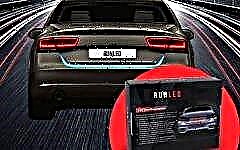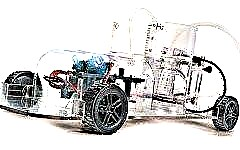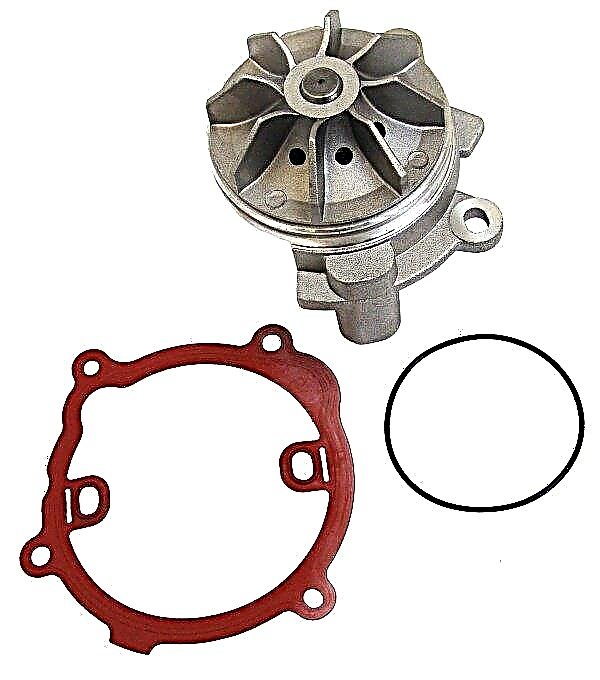Comfort in the car is the most important thing for many, but sometimes you want to embody a sporty and comfortable type of driving in one. Let's talk about the principle of operation and the structure of the system.

The content of the article:
- Suspension purpose
- Components
- System varieties
- Principle of operation
- Installation and repair cost
When landing and driving for a short time in a car, any person first of all thinks about comfort, whether the suspension is hard or soft. Some people prefer a soft suspension, while others like a sporty option, but you can combine several different suspensions in one thanks to the active suspension of the car.
As a result, depending on the driving style and the chosen configuration, the car can turn into both a sports car and an elegant, soft sedan. Each manufacturer has a similar mechanism in its arsenal, they modify it in their own way and, as a rule, are installed on premium cars.
Why install an active suspension

The undercarriage of the car is quite an important and basic element of the entire structure, but in each brand it is arranged in its own way. In more detail, thanks to the stiff suspension, the vehicle's roll is minimal, resulting in good stability and handling on the road. Reversely stiff, soft active suspension will give the car a smooth ride. The downside will be the danger of sharp maneuvers, the controllability and stability of the machine will decrease.
This is the reason why many manufacturers began to develop active suspensions for their vehicles of various designs and purposes. The "active" prefix indicates that the parameters of the suspension may change during its operation. Often these parameters can be changed automatically. Most often, such an active suspension uses shock absorbers with the ability to adjust the degree of damping. More often, such a suspension is then called adaptive or semi-active, since no additional drives are used in it.
In order to understand the difference between a conventional suspension and an active one, it is probably better to drive or at least look from the side. On rough roads, such a suspension is quite noticeable and differs in performance. Even an inexperienced driver will immediately feel the difference when driving in a car.
Active suspension elements

Like any other mechanism, the adaptive suspension consists of several components. Shock absorbers are considered the basis of the entire suspension, in this case they can adjust the stiffness of the suspension. Next in the list is an elastic element, it is also responsible for the rigidity and height of the body.
When it comes to rigidity, then you can't do without an anti-roll bar. The levers can be considered the last on the list, they can be of different lengths and are responsible for the toe-in of the wheels. This list may vary depending on the vehicle manufacturer.
The whole point of the details is to optimally adjust the suspension to the wishes of the driver. To create maximum comfort during the trip. All active suspensions use the effect on several elements. Some manufacturers install paired elements to maximize the desired effect.
Active suspension systems in various vehicles

Taking into account modern advances in technology in the field of car construction, almost every manufacturer has acquired an active suspension. Each car brand has a different name for the active suspension:
- Continuous Damping Control (CDS) - Opel;
- ADS (Adaptive Damping System) - Mercedes-Benz;
- Adaptive Variable Suspension, AVS - Toyota;
- EDC (Electronic Damper Control) - BMW;
- DCC (Adaptive Chassis Control) - Volkswagen.
But still this is not the whole list, it is enough that with the progress of cars, manufacturers change names and modify existing systems.
Such a separate group can be made from systems:
- Dynamic Drive from BMW;
- KDSS (Kinetic Dynamic Suspension System) from Toyota.
It should be understood that, depending on the name and purpose, the principle of operation for the same manufacturer may differ, for this we will consider in more detail several active pendants from different manufacturers. As you can see, the same type of active suspension can be used by different manufacturers. In this case, the mechanical part can be arranged in a similar way.
The principle of operation of active suspensions

During the tuning of the active suspension, the shock absorber's ability can be adjusted in two directions, depending on the type of mechanism itself. The first is the use of solenoid valves in the strut. The second option is to use a special magnetic rheological fluid to fill the shock absorber.
The damping level can be adjusted electronically for each of the shock absorbers separately. In this way, different degrees of rigidity of the active suspension of the vehicle are achieved. If the degree of damping is high, then the suspension will be stiff; with a low degree of damping, the suspension, on the contrary, will be soft.
As already mentioned, there are a lot of different active suspensions from each manufacturer. Still, the adaptive suspension with spring adjustment is more versatile. It allows you to maintain a given body height while also separately adjusting the suspension stiffness. If we consider the design of such a suspension, then it is quite complex. Separate actuators are used to adjust the elastic elements.
In such an active suspension, engineers decided to use classic springs as an elastic element, in combination with hydropneumatic and pneumatic elements.
The Mercedes-Benz ABC Active Suspension uses a hydraulic drive to adjust the spring rate. It pumps oil under high pressure into the shock absorber strut, and the hydraulic fluid of the hydraulic cylinder, in turn, acts on a spring coaxially installed with the shock absorber.

In turn, the control over the hydraulic cylinders of the shock absorbers is carried out by an electronic system, using 13 different sensors. This is the position of the car body. The acceleration of the machine is transverse, vertical and longitudinal, as well as a pressure sensor. It also includes a control unit, sensors, actuators, mostly solenoid valves. As a result of the active suspension, the system excludes various body rolls under different conditions (turning, braking or acceleration). It should be noted that having reached a speed of 60 km / h and above, the system lowers the vehicle's ground clearance by 11 mm, and for aerodynamic resistance these are considerable indicators.
As mentioned above, there are hydropneumatic and pneumatic elements by type. Hydropneumatic elements are typically used in active hydropneumatic suspension. This version of the suspension allows you to change the rigidity and height of the body, depending on the wishes of the driver and driving conditions. This active suspension is based on a hydraulically-based high-pressure drive. All this is controlled by solenoid valves. Such a modern third-generation system can be seen on Citroen cars under the name Hydractive. Simply put, the operation of such a suspension is achieved by pumping hydraulic fluid (usually oil) into certain mechanisms.

If the active suspension is built on pneumatic, elastic elements, then it is referred to as air suspension. Such elements provide adjustment of the body clearance relative to the road surface. The pneumatic drive (electric motor with compressor) builds up pressure in the pneumatic elements.In order to adjust the stiffness of the suspension, the engineers decided to use shock absorbers with the ability to adjust the degree of damping. Most often, such a suspension can be found in Mercedes-Benz cars, with the Airmatic Dual Control marking and the Adaptive Damping System.
In other words, the pressure in the suspension is regulated by air, which is pumped into certain mechanisms, but if there is a hole somewhere in these mechanisms, then the effect of the suspension will not work. The car will simply sit down on the ground. Compared to hydropneumatic suspension, conventional pneumatics will almost immediately stop the movement of the car in the event of a breakdown.
But as they said, there is also a third group of active suspension. It changes the stiffness of the anti-roll bar. Due to the rectilinear movement, the anti-roll bar is simply turned off, and due to this, the suspension travel is increased. Bumps on the road are better worked out, resulting in a smooth ride and high comfort for the driver and passengers.

If the car abruptly changes the direction of movement or enters a turn, then the stiffness of the stabilizer increases relative to the acting forces. Due to this work, body roll is prevented. These are the same active KDSS (Toyota) and DD suspensions from BMW.
Probably the most interesting one to date can be considered the suspension from Hyundai, referred to as AGCS (Active Geometry Control Suspension). The active geometry control system of the suspension allows you to change the length of the levers, as a result of which the toe-in of the rear wheels changes. In order to change the length of the lever, an electronic drive is used.
When entering a corner and accelerating in a straight line, the electronics minimize wheel alignment. When entering a corner at high speed or frequently changing from lane to lane, the toe of the rear wheels increases. As a result, the car will be much more stable and better controllable.
Suspension repair cost

The price of suspension repair depends primarily on the car brand. In particular, the newer the car, the more expensive it is to repair it. Some drivers do not resort to repairs, but to partial restoration of damaged parts.
Often, the active parts of the air suspension fail, since no one canceled the loads during maneuvers and overloads of the car's movement, except if you drive as carefully as possible and at close distances.
The starting price of repairs starts at $ 200, and then you need to look at the parts that are out of order. Air springs cost about $ 150, and the air shock absorber for Mercedes-Benz ML-Class 2005-2011 is about $ 1100.











